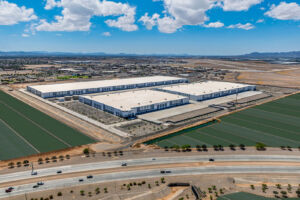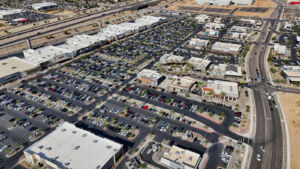Larry Downey, a vice chairman at Cushman & Wakefield, has been in commercial real estate for 37 years (and counting). And while he clearly demonstrates the utmost commitment, admiration and appreciation for his career and chosen industry — especially in the relationships he’s built with his clients — Downey admits the current CRE landscape can be challenging. This is particularly true and applicable with respect to the office space sector, in which he specializes, and trying to figure out Arizona’s commercial real estate outlook for 2024.
MORE NEWS: PTK spotlight: 50 commercial real estate projects to know in 2024
Whereas other sectors have experienced momentum — industrial, for example — the office market continues to fluctuate in the wake of the pandemic, resulting in high vacancy rates combined with negative absorption.
As for when these down trends will improve and/or equilibrium will be achieved in the office sector, Downey predicts it won’t be until the close of 2025 (at the earliest), or perhaps — more likely — another several years and beyond. Until then, Downey says that the office landscape will continue to undergo what he describes as a “reset.”
“It’s a correction period that we’re dealing with,” he says. “In Phoenix, it’s almost a new normal with companies looking to downsize and rightsize their operations in the post COVID hybrid office model.”
The reset and resizing of offices have, in turn, contributed to a sizable vacancy rate. According to a report by Cushman & Wakefield, “the overall vacancy rate across the Phoenix metro office market rose to 27.2%. Of that total, 21.1% was direct vacancy which increased 100 basis points from the previous quarter.” Additionally, the Cushman & Wakefield report demonstrated that “the Phoenix office market recorded negative absorption of 1,123,389 square feet for all building classes in Q3-2023. The forecasted annual negative absorption by year-end 2023 is estimated to be close to negative 4 million square feet.”
“Then there’s a sublease market that’s around five to six million square feet,” Downey adds. “And then you’ve got what’s called ‘the shadow space dilemma.’”
Downey explains shadow space as “extra space carried by companies that they don’t need or utilize.”
“That can be anywhere from 10% to as much as 30%,” he says, “or maybe even more than that in some cases.”
Sublease availabilities, as noted by Cushman & Wakefield “increased by 2.9% quarter-over-quarter in Q3-2023, adding over 180,000 square feet to the market.”
It’s no surprise that in lieu of increased shadow space, companies are reevaluating their square-footage and optimum floor plate size.
“I am doing close to 40 tenant rep transactions this year with my team,” Downey says, “And of those 40, only a handful of tenants have taken more space than they currently have.”

Larry Downey, vice chairman at Cushman & Wakefield. (Photo by Erin Thorburn, AZ Big Media)
With only a fifth of U.S. employees working in an office full-time, and working-from-home trends doubling every 15 years (accelerated by a factor of six resulting from the pandemic), according to a recent Newsweek article, there is some question whether the office market will truly ever recover to pre-COVID normalcy.
“After COVID, people contemplated, ‘What’s going to happen to office space? And are people ever going to come back?’ Well, most want to come back,” Downey says. “The C-Suite leaders of companies — the CEOs, the CFOs— they want their people back in the office.”
But to entice employees back, Downey notes that it will require “collaboration and excitement, which accentuates the ‘flight to quality’ we are seeing among office users.
In regard to how “flight to quality,” applies to the office industry, Downey points to amenity-rich, Class “A” buildings and desirable locations with mass appeal to employees.
Downey identifies “flight to quality” in the Phoenix Metro area with only three submarkets, Camelback, Tempe and Scottsdale that have recorded positive net absorption through the first three quarters,” he says.
On average, these Class A submarkets yield a 21% premium in rental rates, a 119% increase in YTD leasing activity and 23% lower vacancy rates compared with all Class A submarkets.
Beyond flight to quality, Downey notes that total lease activity is down 12% (year-over-year). Furthermore, as vacancies rise, subleasing space increases. “But what’s really interesting, even with these negatives, rental rates are still holding firm.”
To stabilize income on office buildings, Downey says concessions will come into play, “Free rent, along with other concessions. Landlords are still trying to hold firm on their rates. We may see buildings trade based on their vacancies and the new buyers coming in at a lower basis that will reset the rental rates. And that’s when we might see a decline.”
As for more predictions leading into a new year, Downey foresees capital markets sales declining based on investors sitting on the sidelines; lease activity will likely remain deflated; and again we will see negative net absorption in 2024.
Even though his focus market may take time to stabilize, and challenges remain, Downey embraces the solution-oriented side of his career expertise.
“Solving [office sector related obstacles] with CEOs and CFOs and resolving some of the issues they are dealing with both here in Phoenix and multi-markets around the country by using my platform at Cushman & Wakefield is something I welcome,” he says. “Whether it’s to become more efficient, requiring less square footage, moving to another building, negotiating a renewal, blend and extending the term, or whatever else might be needed — it will be challenging, but then, everyone knows I loves a challenge!”




